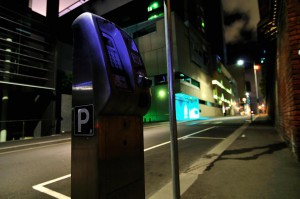
A Sydney company has developed a parking app that it claims could save Australians overfeeding parking meters by $15 million a year, and three local councils have already introduced it.
Sydney company CellOPark has developed an app that that allows motorists to pay for the exact number of minutes they park by using a phone, tablet or computer, providing they don’t overstay a spot.
After registering, motorists call the parking system choosing the zone they have parked in (both are displayed on the street parking signs), hit start on their phones and the system immediately starts charging. Charging stops as soon as the person hits stop.
Parking inspectors can police the system by checking number plates via mobile devices connected to CellOPark.
Drivers can also sign up to the CellOPark premium service for $1.99 a month, which alerts them ten minutes before their parking spot is due to run out. People are not charged if they don’t use the service.
So far three Australian councils have signed up with CellOPark: Canada Bay, NSW; Fremantle, WA and Strathbogie in Vic. Three educational institutions are also part of the scheme: Curtin University in WA, Melbourne Polytechnic and Australian National University in Canberra, which is currently rolling out the scheme.
CellOPark estimates that drivers pay $2 extra every time they park because they are afraid of getting slapped with a parking fine.
The company says that NSW drivers are overpaying $2.50 every time they park, amounting to an annual overspend of $5 million. In Victoria, the figure is $3.8 million.
CellOPark General Manager Michael Doherty said local government should drag parking technology into the 21st century and take pity on poor, paranoid motorists.
“Drivers are being hit with fines left, right and centre, so it’s no surprise they’re guestimating and over-feeding the meter,” Mr Doherty said.
“Taking out this form of ‘parking insurance’ shouldn’t be necessary. There is a real need to update and revitalise the country’s parking systems to make it easier and fairer for motorists.”
He said that CelloPark meant motorists could finally stop paying too much for parking spots. The system worked pro-rata so that a nine-minute dash into a coffee shop was precisely what you paid for in parking fees: nine minutes’ worth.
The system was appealing to councils because of the costs of pay and display machines, “an old-fashioned council asset”: their software licences, upgrades, maintenance and ugliness. It also meant no more parking tickets clogging stormwater drains.
“It’s a matter of only paying for what you use and when you do that you create the ability for motorists to control what they spend,” he said.
The ticketless scheme is also a more efficient parking enforcement system as parking inspectors scan number plates, rather than looking for paper tickets on dashboards. It also took some of the emotional heat out of parking.
“People are frustrated with parking. Let’s face it, it’s a grudge purchase. I f you can take the machines out of the process and not make the motorist walk over to the machine and back to their car to put a ticket in the windscreen it removes a lot of the friction from the whole process of paying for parking.”
Government News contacted Canada Bay Council, which introduced CellOPark for a six-month trial period in Hospital Road, Concord Hospital in May, to find out whether it worked well.
A council spokeswoman said the trial had been successful and the council was considering moving into the second phase of the trial, which would include integration with other parking technologies.
The council has already been trying out another, similar meterless parking phone app called Blue Dot in a Strathfield street.
The spokeswoman said that the ticketless technology improved the pay parking experience by allowing users to pay for parking remotely without needing to find and use a physical parking meter, or have the appropriate change.
“This reduced reliance on physical meters means the number which must be purchased and installed in a pay parking area could be reduced, subject to Road and Maritime Services’ guidelines,” the spokeswoman said.
“The intent of introducing the system is to provide an alternate mode of payment and to improve the integration between the payment technology and other parking technologies.”
One concern which might stop some councils signing up is the possibility that they could lose revenue from people no longer overpaying meters or from parking fines but Mr Doherty said this had not proved to be the case so far.
“Actually we’ve seen parking revenue either stay the same or increase,” he said.
“Someone going into a newsagent wanting to grab a paper or a coffee, if they see no warden around they simply won’t pay for parking. With pay as you go when it’s a start/stop button on an app, people pay.”
Asked what it cost councils to introduce and run the scheme Mr Doherty said it was “a small percentage of the parking revenue”.
“The commercial model that we put to councils is far more palatable for them to make some money out of our system than having their legacy system of pay and display machines on streets,” he said.
“The way we pay for parking has changed very little in over the past 40 years and it’s time for City Councils to address the issue. Over 80 per cent of the motorists we surveyed believe current parking systems need rejuvenating,” said Doherty.
Comment below to have your say on this story.
If you have a news story or tip-off, get in touch at editorial@governmentnews.com.au.
Sign up to the Government News newsletter
